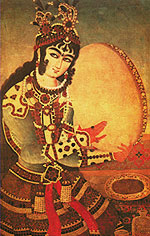|  The
prototypes of Azerbaijani percussion instruments are
rooted in very ancient times, in primitive society.
Back then, people learned to play rhythms in various
ways. The simplest way to keep rhythm was by tapping
one's foot. Then people began experimenting by covering
a well with dry wood and stretching an animal skin
over it. Various rhythmic patterns could be produced
by tapping on the skin. Presumably, the first percussion
instruments originate from those times. The
prototypes of Azerbaijani percussion instruments are
rooted in very ancient times, in primitive society.
Back then, people learned to play rhythms in various
ways. The simplest way to keep rhythm was by tapping
one's foot. Then people began experimenting by covering
a well with dry wood and stretching an animal skin
over it. Various rhythmic patterns could be produced
by tapping on the skin. Presumably, the first percussion
instruments originate from those times.
Even now, one of the zorkhana plays used in wrestling
is called "Ayag-doyma" (foot tapping). There
is a large rock "Gaval Dash" (tambourine)
in one of the ancient human settlements in Gobustan
on the Jingirdagh mountain slopes. By striking or
tapping this stone, one can produce a sound that is
reminiscent of the instrument known as the gaval.
Some people believe that the name "Gaval Dash"
came to us because this stone really was used as a
percussion instrument in the distant past.
Various kinds of percussion instruments were historically
widespread in Azerbaijan and have played a special
role in the spiritual and material life of the Azerbaijani
people.
These
instruments are mainly divided into three types:
1) membranophones,
2) idiophones, and
3) idio-membranophones.
Membranophones include the tabil, kos, (boyuk naghara)
gosha naghara, naghara, dumbak and other instruments
of this type.
Idiophones include earthenware crockery, various types
of laggutu, shakhshakhs (trinkets), zingirovs (bells)
and gumrovs (handbells).
The gaval (tambourine) and daf belong to the third
group.
The naghara is the most widespread of the membranophone
instruments. There are several types of naghara, which
is considered to be the lead instrument in folk ceremonies
and weddings. The naghara differs in size and goes
by various names such as "boyuk naghara"
(big naghara), "jura naghara" (small naghara),
"chiling naghara"(played with drum sticks),
"goltug naghara" (drum held under the arm)
and "el naghara" (hand naghara).
There are two types of construction for nagharas:
single and double. The drums which are played on one
end include the gosha naghara (double naghara), nagharazen,
tabil, daf and gaval. The drums which are played on
both ends are the kos naghara, boyuk naghara (big
naghara), jura naghara and goltug naghara. The goltug
naghara and gosha naghara are the most popular among
these types.
Many of the percussion instruments that have played
an important role in the development of Azerbaijan's
cultural history unfortunately do not exist today.
These include the tabil bas, danbal, mazhar, tabil,
gumrov, zil, duhul, zang, zingirov, kaman, sinj, davul,
nagus, khalkhal and others.
|